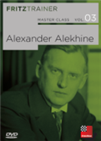 Although almost 100 years have passed since its first edition, many respectable players still consider the book My System by Aron Nimzowitsch to be an indispensable part of chess development. And to be one of the best chess books (maybe the best!) of all time.
Although almost 100 years have passed since its first edition, many respectable players still consider the book My System by Aron Nimzowitsch to be an indispensable part of chess development. And to be one of the best chess books (maybe the best!) of all time.
It was originally published in German as "Mein System" in 1925. Chess historian Edward Winter tells us all about its publication in this article in chesshistory.com, which includes this scan of the front cover by David DeLucia (Darien, CT, USA). An English translation by Philip Hereford, titled "My System," was published in 1929 by G. Bell and Sons.
The book was initially released as a series of five brochures between 1925 and 1927, and the Winter article meticulously traces the history of its publication and historical reactions to it.
In My System, which immediately became popular, Nimzowitsch very clearly laid out the principles of strategy in two parts: the first talks about the elements of strategy, while the second builds upon these elements to talk about positional play. In both parts of the book, Nimzowitsch mostly used games from his own practice as examples (an approach for which he was criticized, considering that many of the principles discussed in the book were known long before him).
 On this DVD GMs Rogozenco, Marin, Müller, and IM Reeh present outstanding games, stunning combinations and exemplary endgames by Alekhine. And they invite you to improve your knowledge with the help of video lectures, annotated games and interactive tests
On this DVD GMs Rogozenco, Marin, Müller, and IM Reeh present outstanding games, stunning combinations and exemplary endgames by Alekhine. And they invite you to improve your knowledge with the help of video lectures, annotated games and interactive testsOne of the few games in My System that is not a Nimzowitsch game is Thomas-Alekhine, Baden-Baden, 1925. Even Alekhine was a little surprised, writing in the book of his best games: "Nimzowitsch – who was rather reluctant to comment on the games of his colleagues – distinguished this one by including it in his remarkable book, My System" (Alekhine: My Best Games, 1924-1937).

Participants in the Baden-Baden tournament in 1925
Both Nimzowitsch and Alekhine explained in their commentary to the game in their respective books how Black used pressure on open files to steadily restrict White’s pieces and ultimately force his resignation. The game is also quoted widely in many other sources, but mostly with comments from either Nimzowitsch or Alekhine, without new comments or analysis.
Many readers of Nimzowitsch’s My System (as well as, of course, readers of Alekhine's book), will easily recall this game because it is so impressive from the strategical point of view. Let us have a look at the position after 34. Rf1 with Black to move:
Please post your remarks in the comments section below and try to find all mistakes. More extensive analysis can be submitted as PGN to feedback to the editors.
.jpeg)

















 Although almost 100 years have passed since its first edition, many respectable players still consider the book My System by Aron Nimzowitsch to be an indispensable part of chess development. And to be one of the best chess books (maybe the best!) of all time.
Although almost 100 years have passed since its first edition, many respectable players still consider the book My System by Aron Nimzowitsch to be an indispensable part of chess development. And to be one of the best chess books (maybe the best!) of all time.





